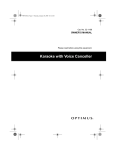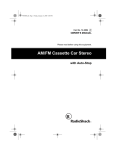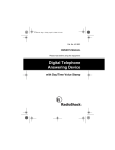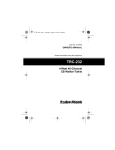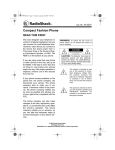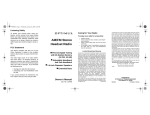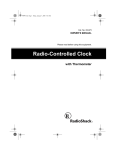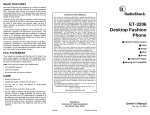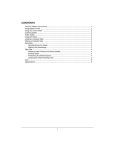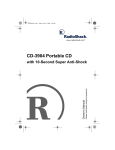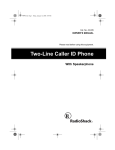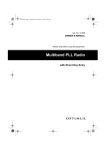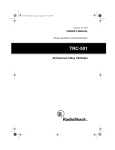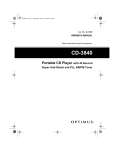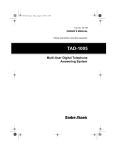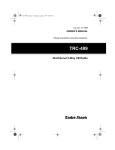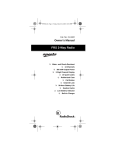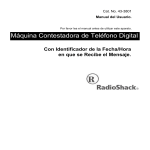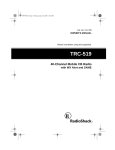Download Radio Shack TRC-239 User's Manual
Transcript
21-1628.fm Page 1 Tuesday, January 25, 2000 9:30 AM Cat. No. 21-1628 OWNER’S MANUAL Please read before using this equipment. TRC-239 40-Channel, 4-Watt CB Walkie-Talkie 21-1628.fm Page 2 Tuesday, January 25, 2000 9:30 AM FEATURES Your RadioShack TRC-239 40-Channel, 4-Watt CB Walkie-Talkie is a portable, easy-to-use, two-way radio that you can carry almost anywhere. It will give you reliable communications in many different applications. You can use your TRC-239 around the house, in your office, car or boat or anywhere on the go. It is useful on fishing and camping trips. Or in your business for security patrols, for supervisors, or warehouse personnel. Its features include: Maximum Allowable Power — lets you transmit at the maximum legal level for the best range possible. Flex Antenna — lets you transmit conveniently in confined quarters. Selectable Transmit Power — lets you adjust the output power to save battery power during shortrange transmissions. TX/BATT (Transmit/Battery Low) Indicator — lights when the TRC-239 transmits and when you should replace or recharge the batteries. Long Battery Life — reduces the need for replacement or recharging. Extends your talk-time. Built-in Charging Jack — lets you recharge optional nickel-cadmium (Ni-Cd) or nickel-metal hydride (Ni-MH) batteries inside the TRC-239. © 2000 Tandy Corporation. All Rights Reserved. RadioShack and Adaptaplug are registered trademarks used by Tandy Corporation. 2 21-1628.fm Page 3 Tuesday, January 25, 2000 9:30 AM Rotary Volume and Squelch Controls — mean faster, easier operation under virtually any condition. Automatic Modulation Limiter — prevents overmodulation to ensure a clear sound. Automatic Noise Limiter — reduces noise caused by nearby electrical equipment such as motors or automotive ignition systems. CHARGE Indicator — lights to indicate that the TRC-239 is charging your optional rechargeable batteries. 3 21-1628.fm Page 4 Tuesday, January 25, 2000 9:30 AM FCC INFORMATION The Federal Communications Commission (FCC) does not require you to have a license to operate this CB. However, the FCC does require that you read and know Part 95 of FCC Rules. These rules apply to the operation of a Class D CB. We have provided a copy of these regulations with your CB. Warning: Do not open your CB to make any internal adjustments. Any internal adjustments can be made only by an authorized service technician. Unauthorized internal adjustments and/or modifications can lead to illegal operation as defined by Part 95 of FCC Rules. Such illegal operation can lead to very serious consequences. To be safe and sure: • Never open your CB’s case. • Never modify your CB. Your CB might cause TV or radio interference even when it is operating properly. To determine whether your CB is causing the interference, turn off your CB. If the interference goes away, your CB is causing it. Try to eliminate the interference by either moving your CB away from the receiver or contacting your local RadioShack store for help. If you cannot eliminate the interference, the FCC requires that you stop using your CB. 4 21-1628.fm Page 5 Tuesday, January 25, 2000 9:30 AM CONTENTS Preparation ........................................................... 6 Powering the CB ............................................. 6 Using the POWER Jack and NI/AL Switch ............................................ 6 Using Batteries ............................................... 7 Using Non-Rechargeable Batteries ......... 7 Using Rechargeable Batteries ................. 8 Charging Tips .......................................... 9 Using Vehicle Battery Power ........................ 10 Using AC Power ............................................ 11 Connecting the Antenna ............................... 12 Connecting an Optional Antenna .......... 13 Operation ............................................................ 15 Receiving Transmissions and Adjusting Squelch ......................................... 15 Transmitting .................................................. 15 CB Operation Tips ............................................. Typical Uses For a CB Radio ....................... Business Uses ...................................... Personal Uses ....................................... CB Courtesy .......................................... 17 17 17 17 18 Using Common 10-Codes ................................. 19 Maximum Range .......................................... 21 Care and Maintenance ....................................... 22 Specifications .................................................... 23 5 21-1628.fm Page 6 Tuesday, January 25, 2000 9:30 AM PREPARATION POWERING THE CB You can power your TRC-239 from any of these sources: • internal batteries (not supplied) • vehicle battery adapter) power (using an optional • household AC power (using an optional adapter) Using the POWER Jack and NI/AL Switch AL NI AA AA AA R CUSTOM MANUFACTURED IN THAILAND FOR RADIOSHACK. A DIVISION OF TANDY CORPORATION. FORT WORTH. TEXAS 76102 FCC ID: AAO2101678 SERIAL NUMBER This device complies with Part 15 of FCC Rules. Operation is subject to the following two conditions: (1) This device may not cause harmful interference, and (2) this device must accept any interference received, including interference that may cause undesired operation. The POWER jack lets you connect an external power source (such as your vehicle’s battery) or an external AC adapter (not supplied), or an external charger (not supplied) to charge rechargeable batteries (not supplied) while they are in the TRC-239. Before connecting anything to POWER, you must set NI/AL correctly. Follow these steps to set NI/AL. 1. Slide the battery compartment cover in the direction of the arrow to remove it. 2. Remove any installed batteries. 3. Set NI/AL as follows: • Set it to AL to use alkaline batteries. 6 21-1628.fm Page 7 Tuesday, January 25, 2000 9:30 AM • Set NI/AL to NI to use rechargeable batteries inside the TRC-239 Warning: To avoid injuring yourself or damaging the TRC-239, connect a battery charger to POWER only when using Ni-Cd or Ni-MH batteries. USING BATTERIES Your TRC-239 can use 9 AA batteries (not supplied) for power. For the best performance and longest life, we recommend RadioShack non-rechargeable alkaline or rechargeable nickel-cadmium/nickel-metal hydride batteries. Cautions: • Use only fresh batteries of the required size and recommended type. • Do not mix old and new batteries, different types of batteries (standard, alkaline, or rechargeable), or rechargeable batteries of different capacities or type. Using Non-Rechargeable Batteries Follow these steps to install non-rechargeable batteries. 1. Slide the battery compartment cover in the direction of the arrow to remove it. 2. Place the batteries in the compartment as indicated by the polarity symbols (+ and –) marked inside. 3. Replace the cover. 7 21-1628.fm Page 8 Tuesday, January 25, 2000 9:30 AM When the TX/BATT indicator lights steadily or the TRC-239 stops operating properly, replace the batteries. Warning: Dispose of old batteries promptly and properly. Do not burn or bury them. Caution: If you do not plan to use the TRC-239 with internal batteries for several months, remove the batteries. Batteries can leak chemicals that can destroy electronic parts. Using Rechargeable Batteries Rechargeable batteries come fully discharged. Before you use them for the first time, you must charge them. You can charge the batteries while they are in the battery compartment using a battery charger, such as RadioShack Cat. No. 23-349 (not supplied). Or you can use an optional external battery charger (not supplied). Warning: Do not try to charge non-rechargeable batteries. They might get very hot and they could explode. Follow these steps to charge nickel-cadmium or nickel-metal hydride batteries in the TRC-239’s battery compartment. 1. Rotate VOLUME upward until it clicks. 2. Set the battery charger’s Ni-Cd/Ni-MH selector switch to the appropriate position. 3. Insert the charger's barrel plug into the TRC239’s POWER jack. 8 21-1628.fm Page 9 Tuesday, January 25, 2000 9:30 AM 4. Plug the charger's other end into a standard AC outlet. It takes 14–16 hours to recharge Ni-MH batteries or 7–8 hours to recharge Ni-Cd batteries that are fully discharged. 5. When the batteries are fully charged, unplug the charger from the AC outlet, then disconnect the charger from the CB. Charging Tips • Fully discharge Ni-Cd batteries occasionally by using the TRC-239 until the TX/BATT indicator lights, then fully recharge the batteries. This helps restore and maintain the ability of the batteries to take a maximum charge. (This does not apply to Ni-MH batteries.) • To prevent damage to rechargeable batteries, never charge them in an area where the temperature is above 122°F (50°C) or below 32°F (0°C). • Do not overcharge batteries. Overcharging can severely reduce the batteries’ useful life. • Always disconnect the charger's AC plug before you disconnect the barrel plug. 22 1- Important: This CB can use nickelcadmium rechargeable batteries. At the end of a nickel-cadmium battery's useful life, it must be recycled 80 or disposed of properly. Contact 0-8 4 3-74 your local, county, or state hazardous waste management authorities for information on recycling or disposal programs in your area or call 1-800-843-7422. Some options that 9 21-1628.fm Page 10 Tuesday, January 25, 2000 9:30 AM might be available are: municipal curbside collection, drop-off boxes at retailers such as your local RadioShack store, recycling collection centers, and mail-back programs. USING VEHICLE BATTERY POWER You can power the TRC-239 from a vehicle’s 12V power source (such as cigarette-lighter socket) using a fused DC power cord that ends in a size M Adaptaplug® adapter (neither supplied). Both are available at your local RadioShack store. Cautions: You must use a power source that supplies 13.8 volts (12-volt nominal) at 1300 mA. Its center tip must be set to positive and its plug must fit the TRC-239's POWER jack. Using a power source that does not meet these specifications could damage the TRC-239 or the power cord. ! • Always connect the fused power cord to the TRC-239 before you connect it to the power source. When you finish, disconnect the fused power cord from the power source before you disconnect it from the TRC-239. If batteries are installed, make sure NI/AL inside the battery compartment is set to the correct position (see “Using Batteries” on Page 7). 10 21-1628.fm Page 11 Tuesday, January 25, 2000 9:30 AM Follow these steps to connect the TRC-239 to your vehicle’s battery power. TX/B AT CHAR T GE VOLUME SQUELCH MIC CIT 13.8V DCARGE CH IZE NS HI BAN D TR PW AN R LO SC EIV ER 1. Plug the power cord’s Adaptaplug into the TRC239’s POWER jack. 2. Connect the other end of the power cord to your vehicle’s cigarette lighter socket. USING AC POWER You can power the TRC-239 using an optional DC power supply that provides 13.8 volts (12-volt nominal) at 1300 mA. You also need a fused power cord that ends in a size M Adaptaplug adapter (neither supplied). Both are available at your local RadioShack store. Cautions: You must use a power supply that supplies 13.8V DC and delivers at least 1300 mA. Its fused connecting cord’s center tip must be set to positive and its plug must fit the TRC-239's POWER jack. Using a power supply that does not meet these specifications could damage the TRC-239, the power cord, or the power supply. ! • Always connect the power supply to the TRC239 before you connect it to AC power. When 11 21-1628.fm Page 12 Tuesday, January 25, 2000 9:30 AM you finish, disconnect the power supply from AC power before you disconnect the power cord from the TRC-239. If batteries are installed for portable use, make sure NI/AL inside the battery compartment is set to the correct position (see “Using Batteries” on Page 7). Follow these steps to connect the TRC-239 to AC power. 1. Connect the Adaptaplug adapter to the power supply’s cord, setting TIP to + (positive). 2. Plug the barrel plug into the TRC-239's POWER jack. 3. Connect the other end of the power cord to your vehicle’s cigarette-lighter socket. 4. Plug the power supply into a standard AC outlet, then turn on the power supply before you turn on the TRC-239. CONNECTING THE ANTENNA Caution: To prevent damage to your TRC-239, you must connect an antenna before you operate it. Follow these steps to attach the supplied flexible antenna to your TRC-239. 12 21-1628.fm Page 13 Tuesday, January 25, 2000 9:30 AM 1. Align the slots around the antenna’s connector with the tabs on the antenna jack on top of the TRC-239. 2. Press the antenna down over the jack and turn the antenna’s base clockwise until it locks. To remove the antenna, turn the antenna’s base counterclockwise until it unlocks, then lift it off the antenna jack. Connecting an Optional Antenna The TRC-239 comes with a flexible antenna (equipped with a BNC connector) that is ideal for most applications. However, the BNC connector makes it easy to connect other types of antennas, too. For mobile or base station use, you might want to connect an optional external antenna. Your local RadioShack store carries a wide selection of external mobile or outdoor base station antennas. Choose the one that best meets your needs. When deciding on a mobile or base station antenna and its location, consider the following: • The location of the antenna should be as high as possible. • The antenna and antenna cable should be as far as possible from sources of electrical noise (appliances, other radios, and so on). • The antenna should be vertical for the best performance. 13 21-1628.fm Page 14 Tuesday, January 25, 2000 9:30 AM Note: When connecting an optional antenna, always use 50-ohm coaxial cable such as RG-58. For lengths over 50 feet, use low-loss RG-8 coaxial cable. When the cable terminates in a PL-259 connector, obtain an adapter to fit the BNC connector. Follow the installation instructions supplied with the antenna, route the antenna cable to the TRC-239, then connect it to the antenna jack. Cautions: • Do not run the cable over sharp edges or moving parts. • Do not run the cable next to power cables or other CB antenna cables. • Do not run the cable through a vehicle’s engine compartment or other areas that produce extreme heat. • Follow all cautions and warnings included with the antenna. Warning: When installing or removing a base station CB antenna, use extreme caution. If the antenna starts to fall, let it go! It could contact overhead power lines. If the antenna touches the power line, contact with the antenna, mast, cable, or guy wires can cause electrocution and death! Call the power company to remove the antenna. DO NOT attempt to do so yourself. 14 21-1628.fm Page 15 Tuesday, January 25, 2000 9:30 AM OPERATION Before you start using your TRC-239, we recommend you read “CB Operation Tips” on Page 17, which contains information to help you use the TRC239 effectively and courteously. RECEIVING TRANSMISSIONS AND ADJUSTING SQUELCH Caution: Before receiving or transmitting, always connect the antenna. 1. Rotate SQUELCH fully towards the top of the CB. 2. Rotate VOLUME toward the bottom of the CB until it clicks. The CB turns on and a channel appears. Increase the volume to a comfortable listening level. (You might hear a hiss if there is no signal on the selected channel.) 9 8 or until the desired channel 3. Press CH appears on the display. To move rapidly through the channels, hold down or . 9 8 4. Rotate SQUELCH toward the bottom of the TRC239 until any hiss just stops. This lets you hear transmissions without background noise. Rotating the control further decreases the TRC-239’s sensitivity to incoming signals. 5. To turn off the TRC-239, rotate VOLUME upward until it clicks. TRANSMITTING 1. Follow Steps 1–4 in “Receiving Transmissions and Adjusting Squelch.” 15 21-1628.fm Page 16 Tuesday, January 25, 2000 9:30 AM 2. Based on your desired transmitting range, set the power level as follows. • To increase the transmitted signal strength and the TRC-239's range, set PWR HI/LO to HI. • To decrease the transmitted signal strength (to prevent overloading a nearby CB) and save battery power, set PWR HI/LO to LO. 3. Hold the CB 2 to 3 inches from your mouth. Hold down PTT (push to talk) and speak into the microphone on the front of the CB in a normal voice. TX/BATT lights. 4. When you finish speaking, release PTT. Important! Channels 9 and 19 are reserved for motorist assistance and for reporting emergency information about accidents, hazardous road conditions, and so on. Always give emergency communications priority on Channels 9 and 19. 5. To turn off the TRC-239, rotate VOLUME upward until it clicks. 16 21-1628.fm Page 17 Tuesday, January 25, 2000 9:30 AM CB OPERATION TIPS Like most activities, CB radio users have customs and courtesies. The following tips will help you get the most enjoyment out of your CB. TYPICAL USES FOR A CB RADIO Business Uses • Truck drivers and delivery personnel can learn road and traffic conditions and get assistance in locating destinations. A CB is also good company on these “long hauls.” • Used by construction crews, a CB quickly pays for itself when you are calling for additional materials or coordinating the activities of different work crews. • For security officers, a CB is more than a convenience — it is a must for both safety and efficiency. Personal Uses • Keep in touch with home while driving to work, to the store, or to a social activity. Let your family know you are tied up in traffic or that you will stop by the store on the way home. • If you are a two-or-more car family, CBs are great for inter-car communications while family members are going places. • Contact friends or neighbors — find out “what's happening” or plan a get-together. 17 21-1628.fm Page 18 Tuesday, January 25, 2000 9:30 AM • Ever have car trouble or run out of gas on the highway? With your CB you can have peace of mind knowing you can call for assistance. • Camping, fishing, and other sports are more fun with a CB. Keep in touch with a buddy or find out “what's cooking” back at camp. CB Courtesy • Wait for a pause in someone else's transmission before you ask for a break. • If you do not receive an answer to your call after a second attempt, sign off and wait several minutes before trying again. • Do not hold down PTT, called “dead keying”, when you are not talking. • Assist callers with directions, information about road conditions, and any other reasonable requests. 18 21-1628.fm Page 19 Tuesday, January 25, 2000 9:30 AM USING COMMON 10-CODES Citizen’s Band operators have largely adopted the 10-codes for standard questions and answers. These codes permit faster communication and better intelligibility in noisy areas. While not all codes are listed, most of the more popular ones follow. Code Meaning 10-1 Receiving poorly. 10-2 Receiving well. 10-3 Stop transmitting. 10-4 OK, message received. 10-5 Relay message. 10-6 Busy, please stand by. 10-7 Out of service. 10-8 In service 10-9 Repeat message. 10-10 Transmission completed, standing by. 10-11 Talking to rapidly. 10-12 Visitors present. 10-13 Advise Weather/Road conditions. 10-17 Urgent business. 10-18 Anything for us? 10-19 Nothing for you. Return to base. 10-20 My location is____. 10-21 Call by telephone. 10-22 Report in person to____. 19 21-1628.fm Page 20 Tuesday, January 25, 2000 9:30 AM Code Meaning 10-23 Please stand by. 10-25 Can you contact____. 10-26 Disregard last information. 10-27 I am moving to channel____. 10-28 Identify your station. 10-32 I will give you a radio check. 10-33 Emergency traffic. 10-36 Correct time is____. 10-37 Wrecker needed at____. 10-38 Ambulance needed at______ 10-41 Please turn to channel_____. 10-42 Traffic accident at_____. 10-43 Traffic tie-up at____. 10-50 Break channel. 10-62 Unable to copy; use telephone. 10-70 Fire at_____. Note: Although this table lists the 10-codes’ meanings in the form of a statement, they can also be phrased as questions (10-6: Are you busy?, 10-20: What is your location?). 20 21-1628.fm Page 21 Tuesday, January 25, 2000 9:30 AM MAXIMUM RANGE The maximum range and quality of CB transmissions vary depending on the following typical conditions: • the type and quality of antenna used • the height of the antenna's mounting location — the higher the antenna, the greater the signal's range • the surrounding terrain — mountains and tall buildings limit the range • weather conditions • the number of nearby CBs operating on the same channel 21 21-1628.fm Page 22 Tuesday, January 25, 2000 9:30 AM CARE AND MAINTENANCE Your RadioShack TRC-239, 40-Channel, 4-Watt, CB Walkie-Talkie is an example of superior design and craftsmanship. The following suggestions will help you care for your CB so you can enjoy it for years. Keep the CB dry. If it gets wet, wipe it dry immediately. Liquids might contain minerals that can corrode the electronic circuits. Keep the CB away from dust and dirt, which can cause premature wear of parts. Handle the CB gently and carefully. Dropping it can damage circuit boards and cases and can cause the CB to work improperly. Use only fresh batteries of the required size and recommended type. Batteries can leak chemicals that damage your CB’s electronic parts. Wipe the CB with a damp cloth occasionally to keep it looking new. Do not use harsh chemicals, cleaning solvents, or strong detergents to clean the CB. Modifying or tampering with the CB’s internal components can cause a malfunction and might invalidate its warranty and void your FCC authorization to operate it. If your CB is not performing as it should, take it to your local RadioShack store for assistance. 22 21-1628.fm Page 23 Tuesday, January 25, 2000 9:30 AM SPECIFICATIONS RECEIVER Frequency Coverage ............. 26.965 to 27.405 MHz Audio Output ............................ 400 mW (10% THD) Intermediate Frequency ............. 1st IF: 10.695 MHz 2nd IF: 455 kHz TRANSMITTER Frequency Coverage ............. 26.965 to 27.405 MHz Output Power ................. 4 Watts (HI), 1 Watt (LOW) Antenna Impedance .................................... 50 Ohm Current Drain: with 80% modulation ................... 700/1300 mA without modulation ......................... 500/850 mA GENERAL Power Requirements ........ 12V DC or 9 AA batteries Operating Temperature Range ................ 0° to 140°F (–18° to 60°C) Size and Type of Batteries: AA Alkaline, Ni-Cd, or Ni-MH Number of Batteries ............................................... 9 DC Input Jack ................ Type M Adaptaplug adapter with tip positive Specifications are typical; individual units might vary. Specifications are subject to change and improvement without notice. 23 21-1628.fm Page 24 Tuesday, January 25, 2000 9:30 AM Limited Ninety-Day Warranty This product is warranted by RadioShack against manufacturing defects in material and workmanship under normal use for ninety (90) days from the date of purchase from RadioShack companyowned stores and authorized RadioShack franchisees and dealers. EXCEPT AS PROVIDED HEREIN, RadioShack MAKES NO EXPRESS WARRANTIES AND ANY IMPLIED WARRANTIES, INCLUDING THOSE OF MERCHANTABILITY AND FITNESS FOR A PARTICULAR PURPOSE, ARE LIMITED IN DURATION TO THE DURATION OF THE WRITTEN LIMITED WARRANTIES CONTAINED HEREIN. EXCEPT AS PROVIDED HEREIN, RadioShack SHALL HAVE NO LIABILITY OR RESPONSIBILITY TO CUSTOMER OR ANY OTHER PERSON OR ENTITY WITH RESPECT TO ANY LIABILITY, LOSS OR DAMAGE CAUSED DIRECTLY OR INDIRECTLY BY USE OR PERFORMANCE OF THE PRODUCT OR ARISING OUT OF ANY BREACH OF THIS WARRANTY, INCLUDING, BUT NOT LIMITED TO, ANY DAMAGES RESULTING FROM INCONVENIENCE, LOSS OF TIME, DATA, PROPERTY, REVENUE, OR PROFIT OR ANY INDIRECT, SPECIAL, INCIDENTAL, OR CONSEQUENTIAL DAMAGES, EVEN IF RadioShack HAS BEEN ADVISED OF THE POSSIBILITY OF SUCH DAMAGES. Some states do not allow limitations on how long an implied warranty lasts or the exclusion or limitation of incidental or consequential damages, so the above limitations or exclusions may not apply to you. In the event of a product defect during the warranty period, take the product and the RadioShack sales receipt as proof of purchase date to any RadioShack store. RadioShack will, at its option, unless otherwise provided by law: (a) correct the defect by product repair without charge for parts and labor; (b) replace the product with one of the same or similar design; or (c) refund the purchase price. All replaced parts and products, and products on which a refund is made, become the property of RadioShack. New or reconditioned parts and products may be used in the performance of warranty service. Repaired or replaced parts and products are warranted for the remainder of the original warranty period. You will be charged for repair or replacement of the product made after the expiration of the warranty period. This warranty does not cover: (a) damage or failure caused by or attributable to acts of God, abuse, accident, misuse, improper or abnormal usage, failure to follow instructions, improper installation or maintenance, alteration, lightning or other incidence of excess voltage or current; (b) any repairs other than those provided by a RadioShack Authorized Service Facility; (c) consumables such as fuses or batteries; (d) cosmetic damage; (e) transportation, shipping or insurance costs; or (f) costs of product removal, installation, set-up service adjustment or reinstallation. This warranty gives you specific legal rights, and you may also have other rights which vary from state to state. RadioShack Customer Relations, 200 Taylor Street, 6th Floor, Fort Worth, TX 76102 We Service What We Sell 01A00 12/99 937568 Printed in Thailand
























